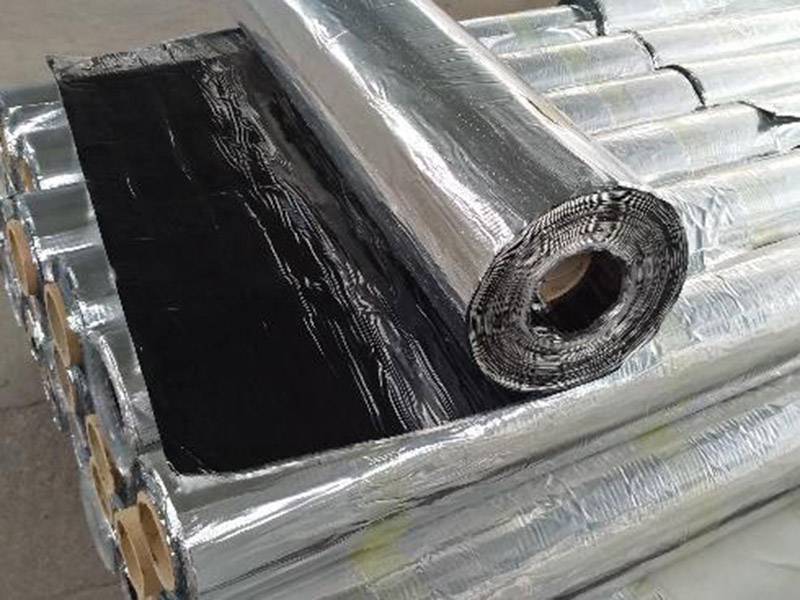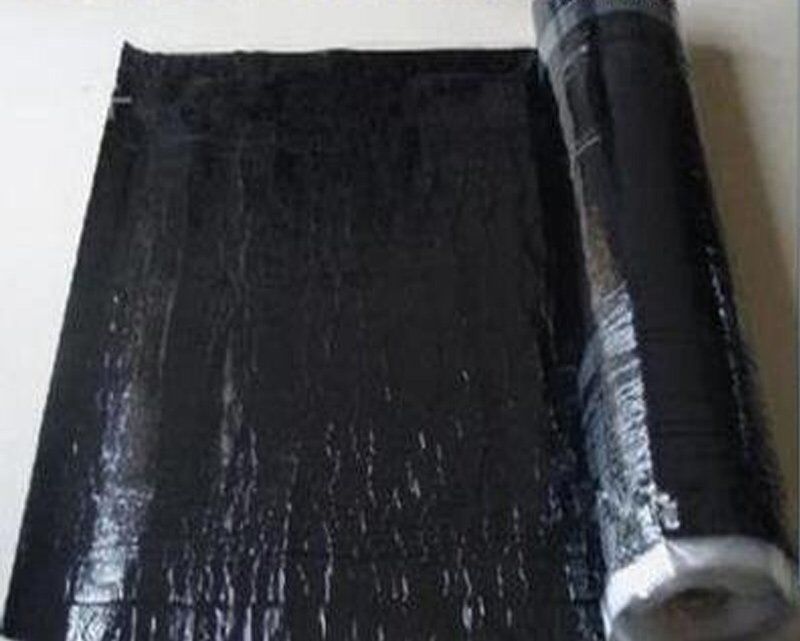Self-adhesive polymer-modified asphalt waterproof Membranes
Self-adhesive polymer-modified asphalt waterproof Membranes
Self-adhesive polymer-modified bitumen waterproofing membrane is based on polymer-modified bitumen based on SBS, with polyethylene film, aluminum foil as surface material or no film (double-sided self-adhesive), using anti-sticking isolation layer Self-adhesive waterproof membrane is a new type of building waterproof material with broad development prospects. It has excellent water impermeability, low-temperature flexibility, extensibility, and cohesiveness.
Performance characteristics:
- There is no need for adhesives, and there is no need to heat and bake until it melts. It only needs to remove the isolation layer, and it can be firmly bonded to the base layer. The construction is convenient and the construction speed is extremely fast.
- It has the elasticity of rubber and excellent elongation, which can well adapt to the deformation and cracking of the base layer.
- It has excellent adhesion to the base layer, and the adhesion is often greater than its shearing force (breakage outside the bonding surface).
- Self-healing, that is, when the coiled material is punctured or embedded with hard objects, it will automatically heal with these objects, so it can still maintain good waterproof performance.
- The construction is safe, does not pollute the environment, the construction is simple and clean, and it is easy to achieve civilized construction on site.
- In addition to the main material, the surface material polyethylene film also has excellent water resistance and high strength (polyethylene polypropylene fiber membrane is only waterproof with this film), so waterproof has double insurance.
- Corrosion resistance, the coil has good acid resistance, alkali resistance, chemical corrosion resistance (except for the surface part of the aluminum foil coil), and excellent aging resistance.
Classification
The products are divided into the non-tread base (N-type) and polyester base (PY type) according to the presence or absence of sub-base reinforcement.
Type N is divided into polyethylene film (PE), polyester film (PET), and double-sided self-adhesive without film (D) according to the upper surface material.
PY type is divided into polyethylene film (PE), fine sand (S), and non-film double-sided self-adhesive (D) according to the upper surface material.
Products are divided into Type I and Type II according to performance, and the PY type with a coil thickness of 2.0mm is only Type I.
Specifications:
Area: 10㎡, 15㎡, 20㎡, 30㎡
Width: 1000mm, 2000mm
Thickness: Type N: 1.2mm, 1.5mm, 2.0mm; Type PY 2.0mm, 3.0mm, 4.0mm.
Marking
Label according to product name, category, type, upper surface material, thickness, area, and standard number. For example, 20㎡, 2.0mm thick polyethylene film surface type I type N self-adhesive polymer modified bitumen waterproofing membrane should be marked as N I PE2.0 20GB23441-2009.
The implementation of standards and performance indicators: the implementation of GB23441-2009 standard
Selection points
- It is suitable for waterproofing roofs, underground, indoors, municipal works, pools, swimming pools, and subway tunnels of industrial and civil buildings. It is also suitable for waterproofing wooden and metal structure roofs, especially for oil depots and chemical industries where open flames are not suitable. Factories, textile mills, grain depots, and other re-waterproofing projects.
- PE type has low heat resistance, so it is only suitable for the underground engineering of general and mid-range buildings and the roof with a rigid waterproof protective layer as the waterproof layer. The roof should be used as the protective layer immediately after use.
- When used alone, the thickness should not be less than 2mm. For two or more fortifications, the thickness of each layer of coiled material should not be less than 1.5mm. Thickness 1.2mm and non-membrane (N-type) membranes are only used as auxiliary waterproofing.
Construction process:
- Process flow:
Base treatment — brushing base treatment agent — western additional layer — large surface self-adhesive coil paving — exhaust compaction (steel roller rolling) — lap construction — protection Isolation layer construction
- Grassroots cleaning:
The base layer should be conducive to the laying and pasting of coiled materials, and it is required to be compacted and flat, with a smooth surface, clean and dry, no dust and oil, and a moisture content of no more than 9%.
Brushing or spraying base treatment agent: if the base is clean and free of dust, no base treatment agent is required. The wooden iron layer can also be without the base treatment agent.
Construction of additional waterproof layer for detailed nodes: After the base treatment agent dries, treat the parts that need to be the additional waterproof layer in time according to relevant specifications or design requirements. It is advisable to use a blowtorch to assist the details that are not easy to stick to the coil. The additional layer of coils in general parts should be fully adhered to the base layer, and the parts with concentrated stress should be laid empty according to the specifications.
Large surface self-adhesive roll material paving:
- First spread the roll material in front of the reference line, lift the roll material (together with the release paper) from one end, fold it in half along the center line of the roll material, and gently cut the release paper on the back of the roll material with a paper-knife, carefully torn apart
500mm, align the roll with the release paper to the reference line and position it. Then spread the lifted half-width roll material back into place; pull the peeled-off release paper and pull it to the right, slowly pull out all the release paper of the half-width roll material, and press the roll material tightly. Lay the other half of the coil according to the above method, pay attention to the integrity of the release paper at any time during the spread, stop the spread immediately if it is torn or broken, clean up the torn residual release paper, and then continue the construction.
- After the coiled material is pasted, use a pressure roller to roll from the middle of the coiled material to both sides to discharge the air, so that the coiled material can be firmly pasted on the base layer. Construction personnel should avoid polluting the surface of the rolled material that has been pasted, so as not to affect the overlapping of the rolled material.
- Both the long and short sides of the overlapping width of the coil are not less than 100mm. Roll the overlapping parts of the coils from the inside to the outside with a hand-held small pressure roller to discharge the air, and then seal with a special sealing material, and the sealing width is not less than 10mm.
- For the end of the coiled material, end of the coiled material should be trimmed, stuffed into the reserved groove, and sealed tightly with a special sealing material. Immediate construction needs to be firmly nailed with steel nail sealing strips and sealed tightly with special sealing materials.
Construction of the protective layer: after the construction of the waterproof layer is completed, if it passes the acceptance, use cement mortar or fine stone concrete as the protective layer.
Wet laying self-adhesive membrane construction technology
(Applicable to concrete bases with a moisture content greater than 9% such as basement pre-slabs, side walls, and layers)
Technological process: base cleaning, wetting—positioning, thread springing—cement (sand) slurry—additional layer reinforcement for nodes—large surface paving and self-adhesive coil—lifting pulp, exhausting—lapping edge pasting —Protective layer construction
- Clean and moisten the base: Clean up the dust and debris on the surface of the base. The dry base should be pre-sprinkled with water, but there should be no residual water.
- Plastering of cement (sand) slurry: Determine the thickness according to the leveling condition of the floor, pay attention to compaction and smoothing, and the inner corners should be smeared into an arc shape of more than 50mm, and pay attention to ensuring smoothness during the whole process of paving Spend.
- Enhancement of additional layers of joints: An additional layer should be made first at joints (such as yin and yang corners, corners, construction joints, post-casting belts, deformation joints, wall pipes, etc.).
- Large-surface self-adhesive coil paving: Remove the isolation film on the lower surface of the self-adhesive coil, and spread the coil on the base layer with cement mortar. After the first coil is laid, cement mortar is applied. Lay down the second roll, and so on.
- Raising pulp and exhausting: beat the surface of the coiled material with a wooden trowel or rubber plate, lift the pulp, and discharge the accumulated air on the lower surface of the self-adhesive coiled material, so that the coiled material and cement mortar are tightly bonded together.
- Lap joint side paste: According to the actual situation on-site, you can choose to carry out lap joint side paste when paving the coiled material or wait for the cement mortar to reach sufficient strength before performing lap joint side paste; when lap joint side paste, the upper and lower Remove the overlapping part of the upper and lower isolation films of the coil, and attach the upper coil to the lower coil, and the overlapping width of the coil should not be less than 100mm.
- Construction of the protective layer: After the construction of the waterproof layer is completed, if it passes the acceptance, use cement mortar or fine stone concrete as the protective layer.
Storage and transportation
- Coiled materials should be stored in a dry and ventilated environment to prevent sun and rain.
- Coils of different specifications should be stacked separately.
- Coiled materials should be packed in boxes and placed flat, and the stacking height should not exceed 5 layers.
- Under normal conditions, the storage period is one year (calculated from the date of production)
- The coiled material should be placed flat during transportation, not tilted or crossed, and protected from the sun and rain.
Precautions
- Don’t use non-exposed coils in the environment of exposed use.
- Do not spread the self-adhesive membrane on a frozen base surface.
- Do not construct on a polluted base.
- The packaging and release paper of self-adhesive rolls can only be removed before and during laying.
- When the sealant is not used up, the container should be tightened and sealed in time.
- Do not use the supporting materials of other manufacturers in this product without verification.
- The suitable construction temperature of the coil is 5℃~35℃. When the temperature is lower than 5°C, the adhesiveness of the coil will decrease, and it should be bonded after heating with a hot air welding torch.
- Should not be constructed in rainy snow and windy weather above grade five.
- The safety protection facilities at the construction site are complete, and fire-fighting equipment is placed according to regulations.


